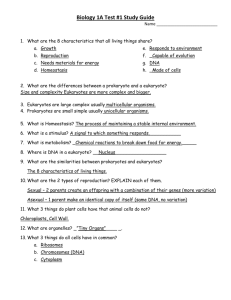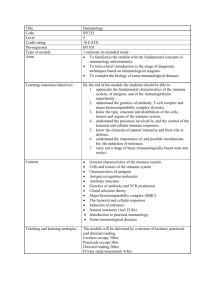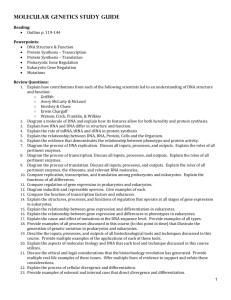JULY
advertisement
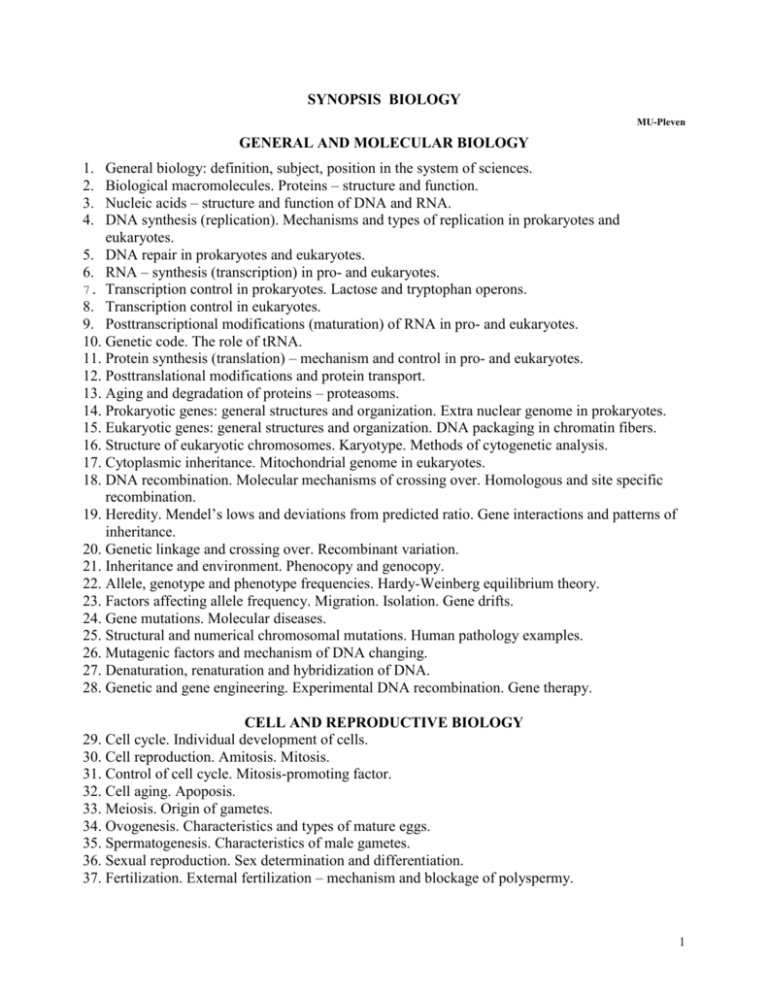
SYNOPSIS BIOLOGY MU-Pleven GENERAL AND MOLECULAR BIOLOGY 1. 2. 3. 4. General biology: definition, subject, position in the system of sciences. Biological macromolecules. Proteins – structure and function. Nucleic acids – structure and function of DNA and RNA. DNA synthesis (replication). Mechanisms and types of replication in prokaryotes and eukaryotes. 5. DNA repair in prokaryotes and eukaryotes. 6. RNA – synthesis (transcription) in pro- and eukaryotes. 7. Transcription control in prokaryotes. Lactose and tryptophan operons. 8. Transcription control in eukaryotes. 9. Posttranscriptional modifications (maturation) of RNA in pro- and eukaryotes. 10. Genetic code. The role of tRNA. 11. Protein synthesis (translation) – mechanism and control in pro- and eukaryotes. 12. Posttranslational modifications and protein transport. 13. Aging and degradation of proteins – proteasoms. 14. Prokaryotic genes: general structures and organization. Extra nuclear genome in prokaryotes. 15. Eukaryotic genes: general structures and organization. DNA packaging in chromatin fibers. 16. Structure of eukaryotic chromosomes. Karyotype. Methods of cytogenetic analysis. 17. Cytoplasmic inheritance. Mitochondrial genome in eukaryotes. 18. DNA recombination. Molecular mechanisms of crossing over. Homologous and site specific recombination. 19. Heredity. Mendel’s lows and deviations from predicted ratio. Gene interactions and patterns of inheritance. 20. Genetic linkage and crossing over. Recombinant variation. 21. Inheritance and environment. Phenocopy and genocopy. 22. Allele, genotype and phenotype frequencies. Hardy-Weinberg equilibrium theory. 23. Factors affecting allele frequency. Migration. Isolation. Gene drifts. 24. Gene mutations. Molecular diseases. 25. Structural and numerical chromosomal mutations. Human pathology examples. 26. Mutagenic factors and mechanism of DNA changing. 27. Denaturation, renaturation and hybridization of DNA. 28. Genetic and gene engineering. Experimental DNA recombination. Gene therapy. CELL AND REPRODUCTIVE BIOLOGY 29. Cell cycle. Individual development of cells. 30. Cell reproduction. Amitosis. Mitosis. 31. Control of cell cycle. Mitosis-promoting factor. 32. Cell aging. Apoposis. 33. Meiosis. Origin of gametes. 34. Ovogenesis. Characteristics and types of mature eggs. 35. Spermatogenesis. Characteristics of male gametes. 36. Sexual reproduction. Sex determination and differentiation. 37. Fertilization. External fertilization – mechanism and blockage of polyspermy. 1 38. Internal fertilization in mammals. In vitro fertilization. 39. Animal development. Mechanisms in mammals and humans. IMMUNOLOGY 40. Immunological homeostasis. Organs and cells of immune system. 41. Innate and acquired immunity. 42. Immunogenes and antigens – characteristics. 43. Alloantigens in man – ABO/H systems, 44. Alloantigens in man - Rhesus, Lewis, Secretors. 45. Antibodies – structure and functions. Biological properties of immunoglobulin classes. 46. Antigen-antibody interactions. Immunological methods. 47. The genetic basis of antibody structure. Ontogeny of B-lymphocytes. 48. The genetic basis of T-cell receptor. Ontogeny of T-lymphocytes. 49. Complement. Pathways of complement activation. 50. Types of immune response. Primary and secondary immune response. 51. Major histocompatibility complex in the immune response. 52. Antigen-presenting cells. Immune response against endogenous and exogenous antigens. 53. Cellular immunity. Cell-cell interactions in immune response. T- and B-cell receptors and their activation. 54. Transplantation immunology. Immune response in Graft rejection. Adoptive immunity. Graft versus host reactions. 55. Control of the immune processes. Immune tolerance. Types of immune tolerance. 56. AIDS PARASYTOLOGY 57. Parasites and parasitism. Parasite-host interactions. Classification of parasites and diseases. 58. Characteristics of Protozoa. Trypanososma gambiense, T. rhodesiense, T. cruzi. 59. Leishmania donovany, L. tropica, L. infantum, L. mexicana. 60. Giardia lamblia. 61. Trichomonas vaginalis, T. Hominis, T. tenax. 62. Subphylum Sarcodina. Entamoeba histolytica, E. coli, Balantidium coli. 63. Phylum Apicomplexa. Toxoplasma gondii. Opportunistic infections. 64. Plasmodium vivax, P. malariae, P. falciparum. 65. Class Cestoda. Taenia solium, T. saginata. 66. Taenia echicoccus, Hymenolepis nana, Diphyllobothrium latum. 67. Phylum Nemathelminthes. Ascaris lumbricoides, Enterobius vermicularis, Trichinella spiralis, Trichiuris trichiura. 68. Phylum Artropoda. Spiders and scorpions. 69. Ticks and mites – their role in vector-born diseases. 70. Insects – their role in vector-born diseases. 71. Pediculus hominis, Phthirus pubis. 72. Cimex lectularis, Pulex irritans. 73. Mosquitoes - Genus Culex and genus Anopheles. 74. Phlebotomus papatasii, Musca domestica. 2 RECOMMENDED BOOKS 1. 2. 3. 4. 5. 6. 7. Medical parasitology (Markell and Voge’s) David T. John, William A. Petri,Jr ninth edition, 2006 Basic clinical parasitology. F. Neva, B. Braun. Prentice Hall International Editions, 1994 J. Darnell, H. Lodish, D. Baltimore. MOLECULAR CELL BIOLOGY. Scientific American Books, 6th edition 2010 www.whfreeman.com/lodish Biological science. N.P.O. Green, G.W. Stout, D. J. Taylor. Cambridge edition, 1996 Ch. Janeway et al. Immunobiology, Garland Science, 7th edition Benjamini E., S. Leskowitz, Immunology: A Short Course. Wiley-Liss Inc., New York, 1991, 2003, 2009 (sixth edition) Roitt I., J. Brostoff, D. Male, Immunology, Mosby-Year Book Europe Ltd., London, 1993.; 6 -th edition 2011. Head of Biology Dept: (Assoc. Prof. М. Atanasova, PhD) 3

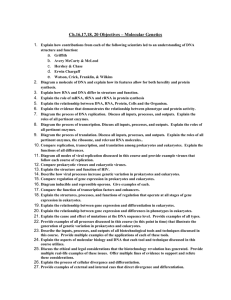
![Cell Game Board [10/16/2015]](http://s3.studylib.net/store/data/007063627_1-08082c134bbc8d8b7ad536470fbed9dc-300x300.png)

